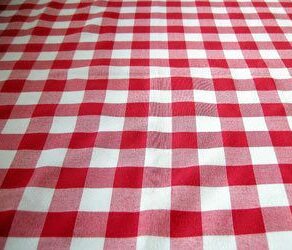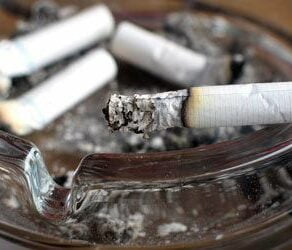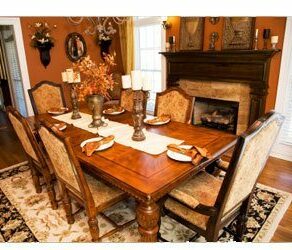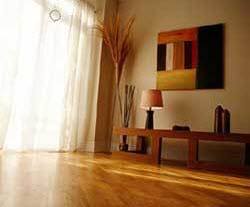Warisha asked: “How do I remove sticky dirt from my wooden chairs? Our dining chairs have dark wooden polish on them, but they also have a thick layer of dirt. How can i get rid of that dirt without damaging the original polish and get the shine back on them? Please kindly recommend some home remedy for this problem.”
Dirt  and grime can build up on wood furniture over time masking its true beauty. While frequent cleanings will help to avoid this situation, when the buildup is no longer removable with normal cleaning, it will require more powerful solutions to break it loose. Three simple ingredients can break through the dirt and help your pieces return to their original shine.
and grime can build up on wood furniture over time masking its true beauty. While frequent cleanings will help to avoid this situation, when the buildup is no longer removable with normal cleaning, it will require more powerful solutions to break it loose. Three simple ingredients can break through the dirt and help your pieces return to their original shine.
Removing Dirt Buildup
*This method is only for wood furniture that is not painted as it will damage and/or remove the paint.
You Will Need:
- Boiled linseed oil (do NOT use raw linseed oil)
- Turpentine
- White vinegar
- Soft cloths
- Old toothbrush
- Drop cloth, cardboard or other ground covering
- Rubber gloves
- Small disposable container
- Paint stir stick
- Face mask (optional)
- Paper towels
- Vacuum with attachments
Steps to Remove the Dirt Buildup:
- Start by selecting a work area that is very well ventilated. Working outdoors is best as this solution produces a strong smell that you don’t want lingering in your home.
- Prepare the work area by covering the ground with a protective covering such as a drop cloth, large sheets of cardboard, etc. Gather rubber gloves and a mask for yourself.
- Bring the wooden piece outdoors and begin by wiping it down with the paper towels to remove as much of the grime as possible. After you have wiped it off, use the vacuum with the brush attachment to gently brush dirt from the crevices and corners.
- Next, mix together equal parts of the boiled linseed oil, turpentine and white vinegar. (Boiled linseed oil is available at most major hardware stores; you do not have to boil it yourself.)
- Moisten the soft cloths lightly with the solution and gently wipe the dirt and grime off of the wood surface. As you are cleaning, wipe the liquid with the grain of the wood and take caution not to soak the wood.
- Continue cleaning with the cloths just until the dirt is gone, do not scrub too much or it may damage the finish.
- For corners, designs, etc., dip the old toothbrush into the solution and gently work it into the grooves. Follow the grain as much as possible just as before. Wipe away with a clean cloth.
- When no more dirt is showing on the cloths, discontinue any further applications. There is no need to rinse the wood.
- Allow the piece to dry completely.
- When the piece is completely dry, buff with a clean cloth to restore the shine.
- Dispose of any remaining cleaner as well as any cloths with cleaner on them using appropriate methods. They can automatically combust and start a fire, so be sure to dispose of them promptly and properly.
Removing Dirt Buildup Without Chemicals
You Will Need:
- Lemon juice
- Olive oil
- Soft cloths
- Old toothbrush
- Drop cloth, cardboard or other ground covering
- Rubber gloves (optional)
- Small container
- Paper towels
- Vacuum with attachments
Steps to Remove the Dirt Buildup:
- Start by selecting a work area that has plenty of room to easily maneuver around your piece. Working outdoors or in the garage is often best.
- Prepare the work area by covering the ground with a protective covering such as a drop cloth, large sheets of cardboard, etc.
- Bring the wooden piece outdoors and begin by wiping the entire piece down with the paper cloths to remove as much of the grime as possible. After you have wiped it off, use the vacuum with the brush attachment to gently brush dirt from the crevices and corners.
- Next, mix together two parts olive oil with one part lemon juice.
- Moisten the soft cloths lightly with the solution and gently wipe the dirt and grime off of the wood surface. As you are cleaning, wipe the liquid with the grain of the wood and take caution not to soak the wood.
- Continue cleaning with the cloths just until the dirt is gone, do not scrub too much or it may damage the finish.
- For corners, designs, etc., dip the old toothbrush into the solution and gently work it into the grooves. Follow the grain as much as possible just as before. Wipe away with a clean cloth.
- When all dirt is removed, wipe down the entire piece with a clean, lint-free cloth.
- Allow the piece to dry completely.
- When the piece is completely dry, buff with a clean cloth to restore the shine.
Additional Tips and Ideas
- As with any cleaning solution, it is best to apply it to a small hidden area first to test for any affects on the finish.
- If the piece you are cleaning is an antique or a collectible, check with a professional prior to cleaning to ensure that the cleaning method does not affect the value of the piece.
- A popular cleaning product for wood furniture is Murphy’s Oil Soap and is safe to use on all non-wax finished wood pieces. It is readily available at most department stores and home improvement stores. Follow the manufacturer’s instructions for application.









I have a large heavy coffee table and side table. I got sick now, three years later; they are in terrible shape. There is something on them that is maybe a spill; it is white-looking and then there is a smear. I don’t even want to talk about the nicks and scratches and what looks like a water spill that took the finish off. Last but not least, one of the home health ladies sat nail polish remover on the side table!
I have tried the olive oil and lemon juice, but it didn’t help. Taking them outside is not an option. They were very expensive and beautiful.
Any help with any one of these problems will be much appreciated. They are Vineyard Furniture with intricate wood grain so I would have to have a professional refinish them and that is not an option either.
Don’t trust anyone with your furniture! Mine went under water and the experienced person who was to repair and refinish several pieces let his helper do the work and this guy sanded my antiques down too much. That just ruined them as far as I’m concerned. It looks like new furniture. Now, it’s too late and I’m sorry as hell that I didn’t watch them do the work. I’m still learning the hard way at my age.
I’m going to try the equal parts of linseed oil, turpentine and vinegar to clean other furniture that went under water and attempt to redo these pieces myself.
What home remedy will make my furniture shine?
Annette,
The olive oil and lemon solution will make your furniture shine, but is more of a cleaner. Replace the lemon juice with white vinegar for the oil to penetrate the wood more deeply (and increase the shine potential). You could also use mineral oil in place of olive oil.
Another option is a 2:5 oz mix of beeswax and turpentine.
Source: DIY Network – Polishing Wood Furniture
Source: wikiHow – How to Make Furniture Polish Using Olive Oil
Source: TLC Home – Refinishing Wood Furniture with Olive Oil
Thanks for the nice ideas.
Sounds just what I am looking for; can you advise me on the quantities to use on my filthy Victorian dining chairs?
Patricia,
The amount that you need depends on how much surface area you need to clean. For four dining chairs, a half-cup of cleaning solution should be enough. Since you need equal parts of each ingredient (linseed oil, turpentine, and white vinegar), use three tablespoons of each – that is nine tablespoons total, which is just over half a cup. (One cup is 16 tablespoons.) That would give you 1 oz. of cleaning solution per chair (One cup is 8 oz.) Since you mentioned your chairs are really dirty though, you may want to make up a bit more than that since you will need to rotate the cloth to a clean spot more frequently, which will require more cleaner. Using 4 or 5 tablespoons of each ingredient should ensure that you don’t have to mix up another batch.
The label on Murphy’s Oil Soap states “Murphy’s Oil Soap should not be used unfinished, unsealed or waxed wood surfaces because they may be water sensitive.”
My old dining room chairs appear to be “oil” finished, but have a layer of some type of grime on them. Wiping lightly with a cotton cloth produces what appears to be dirt/grime, but also a penetrating oil of medium/dark color as it is almost impossible to wash out of cloth.
These are pine chairs from the late 1960’s or early 1970’s. The dining table appears to have a lacquered finish, but the chairs and china cabinet seem to only have an “oiled” finish.
I very well may be wrong, but any guidance would be much appreciated?!?!
I used Arm & Hammer Toothpaste on my oak nest of tables with a soft cloth.
Gently in a circular motion, it works, but you have to be patient, it’s a slow process, but it worked for me. 🙂
Before researching the different cleaning possibilities, I used Pledge to scrub the arms first on one of the chairs. They are filled with a sticky, dark appearance and feel awful to the touch. The table, however, does not look like baked-on dirt like the chairs, nor feels like it. This set is from the 70’s.
I am not sure what I should do. Perhaps, sand lightly first? Or, just use one of the other cleaning processes mentioned?
Judy,
This is the article that you need: How to Remove Furniture Polish from Wood.
Our bedroom set is from 1957, the year we married. It is a light gray. I always used Lemon Pledge on it, but noticed it had a build up of the Pledge, plus it did not appear to be really clean.
This may sound crazy, but to remove and clean it, I made a weak solution of alcohol and water.
Lo and behold, it worked great. Now I never use furniture polish every time I dust, just a soft cloth. I would say that I use Pledge approx. every 5-6 times a year. All is well, but it worked for me, so please do not think I took a big chance. Actually, after having this bedroom furniture for all these years, if I goofed, I think I deserve a new set!
Can I use white spirit instead of turpentine?
Our oak pre-finished floors were installed by us 12 years ago. It is time to get ready to sell. As another person stated, I was not able to do much for 8 years. The cracks of the hardwood is filled with dark gunk, especially the kitchen. Any ideas how to get this clean? I know ‘coulda woulda shoulda’…but now I need this taken care of. Thanks so much in advance. Oh, I have tried a number of things. I do not think there is an easy fix. Lots of elbow grease. If anyone can point me down the right path, I would so appreciate it!
Rebecca,
It’s step 7 of the Removing Dirt Build-Up method that you need. To speed things up, you can use a soft bristle scrub brush instead of a toothbrush to clean more area at once. Let the cleaning solution sit on the wood for a couple minutes before you start scrubbing so it has a chance to loosen the dirt. The easiest way to do this is to work in rectangular sections. Apply the solution over a 1×3 rectangular section, then by the time you have finished applying the solution to the left side of the rectangle, the right side will have had a minute to sit so you can start scrubbing there. Good luck!
It didn’t work for me. I tried the lemon juice and olive oil tip; no affect… ????????
I have six kitchen chairs that I’m trying to fix and restore to the original finish. They have glue on some of the legs that we’re loose apparently. The finish looks like walnut with oil finish, but I’m not sure. What do you recommend that I do?
Ken,
This is the article you need for removing the glue: How to Remove Super Glue from Wood. The sanding method would probably be the best so that you only remove the exposed glue, not loosen the glue that is holding the legs in place. Good luck!
How do I tell if my piece has a wax finish or not?
Will the boiled linseed oil/turpentine/vinegar mixture damage a wax finish?
Same question for the olive oil/lemon juice mixture.
Hi Betsy,
One of the easiest ways to determmine if a wood finish is wax or polyurethane is to put a drop of water on the surface and let it sit for about ten minutes. Inspect the drop of water and if it is still clear, the finish is polyurethane; if the water has turned white, it’s a wax finish. Good luck!
Source: DoItYourself.com – How to Tell If Furniture Has A Polyurethane Finish